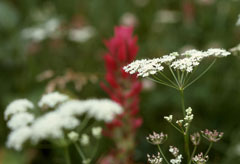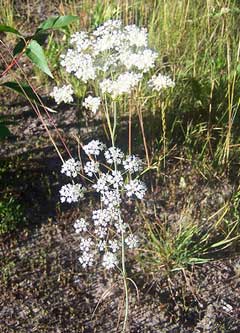 |
|
|
 |
| www.flickr.com/photos/22837563@N08 |
Translate this page:
Summary
Physical Characteristics

 Perideridia gairdneri is a PERENNIAL growing to 1.2 m (4ft). It is in flower from April to May, and the seeds ripen from May to July. The species is hermaphrodite (has both male and female organs) and is pollinated by Insects. The plant is self-fertile.
Perideridia gairdneri is a PERENNIAL growing to 1.2 m (4ft). It is in flower from April to May, and the seeds ripen from May to July. The species is hermaphrodite (has both male and female organs) and is pollinated by Insects. The plant is self-fertile.
Suitable for: light (sandy), medium (loamy) and heavy (clay) soils. Suitable pH: mildly acid, neutral and basic (mildly alkaline) soils. It can grow in semi-shade (light woodland) or no shade. It prefers dry moist or wet soil.
UK Hardiness Map
US Hardiness Map
Synonyms
Carum gairdneri
Plant Habitats
Woodland Garden Sunny Edge; Dappled Shade; Bog Garden; Cultivated Beds;
Edible Uses
Edible Parts: Leaves Root
Edible Uses: Condiment
Root - raw or cooked[60, 61]. A pleasant sweet and nutty taste[2, 46, 95, 161], it can be eaten in quantity as a staple food[183]. It is best used when the plant is dormant[85]. The root can also be dried for later use or ground into a powder and used with cereals when making porridges, cakes etc[183]. The seed is used as a caraway-like seasoning, or can be parched and eaten in porridge or used as piñole[85, 177, 183, 257]. Young leaves - raw or cooked[257].
References More on Edible Uses
Medicinal Uses
Plants For A Future can not take any responsibility for any adverse effects from the use of plants. Always seek advice from a professional before using a plant medicinally.
Carminative Diuretic Laxative Ophthalmic Pectoral Salve
The root is carminative, diuretic, mildly laxative and ophthalmic[94, 257]. An infusion of the roots has been taken to counter the cathartic and emetic effects of another infusion[257]. An infusion of the roots has been applied as a wash to sores and wounds and also used as a nasal wash to get rid of catarrh[257]. A poultice of the roots has been used to draw inflammation from swellings[257]. The juice of the slowly chewed root is said to be beneficial in the treatment of sore throats and coughs[213, 257].
References More on Medicinal Uses
The Bookshop: Edible Plant Books
Our Latest books on Perennial Plants For Food Forests and Permaculture Gardens in paperback or digital formats.

Edible Tropical Plants
Food Forest Plants for Hotter Conditions: 250+ Plants For Tropical Food Forests & Permaculture Gardens.
More

Edible Temperate Plants
Plants for Your Food Forest: 500 Plants for Temperate Food Forests & Permaculture Gardens.
More

More Books
PFAF have eight books available in paperback and digital formats. Browse the shop for more information.
Shop Now
Other Uses
References More on Other Uses
Cultivation details
We have very little information on the cultivation needs of this plant and do not know if it will be hardy in Britain. Judging by its native range it is likely to succeed outdoors in most parts of the country. From its native habitat it is assumed that the plant is fairly tolerant of soil conditions and of sun or shade. Yampa is a marvellous food plant that has been widely used as a staple wild food by native N. American Indians. It is just asking for cultivation in order to improve the root size[85]. For polyculture design as well as the above-ground architecture (form - tree, shrub etc. and size shown above) information on the habit and root pattern is also useful and given here if available. The plant growth habit is a clumper with limited spread [1-2]. The root pattern is tuberous with swollen potato-like roots [1-2].
References Carbon Farming Information and Carbon Sequestration Information
Temperature Converter
Type a value in the Celsius field to convert the value to Fahrenheit:
Fahrenheit:
The PFAF Bookshop
Plants For A Future have a number of books available in paperback and digital form. Book titles include Edible Plants, Edible Perennials, Edible Trees,Edible Shrubs, Woodland Gardening, and Temperate Food Forest Plants. Our new book is Food Forest Plants For Hotter Conditions (Tropical and Sub-Tropical).
Shop Now
Plant Propagation
Seed - we have no information for this species but suggest sowing the seed in a cold frame as soon as it is ripe. Alternatively, sow it in early spring in a cold frame. Prick out the seedlings into individual pots when they are large enough to handle and grow them on in the greenhouse for their first winter, planting out in late spring of the following year. Division may be possible in spring or autumn.
Other Names
If available other names are mentioned here
Native Range
NORTHERN AMERICA: Canada, Saskatchewan (south), Alberta (south), British Columbia (south), United States, South Dakota (west), Colorado, Idaho, Montana, Oregon, Washington, Wyoming, California, Nevada, Utah,
Weed Potential
Right plant wrong place. We are currently updating this section.
Please note that a plant may be invasive in one area but may not in your area so it’s worth checking.
Conservation Status
IUCN Red List of Threatened Plants Status :

Growth: S = slow M = medium F = fast. Soil: L = light (sandy) M = medium H = heavy (clay). pH: A = acid N = neutral B = basic (alkaline). Shade: F = full shade S = semi-shade N = no shade. Moisture: D = dry M = Moist We = wet Wa = water.
Expert comment
Author
(Hook.&Arn.)Mathias.
Botanical References
60
Links / References
For a list of references used on this page please go here
Readers comment
© 2010, Plants For A Future. Plants For A Future is a charitable company limited by guarantee, registered in England and Wales. Charity No. 1057719, Company No. 3204567.